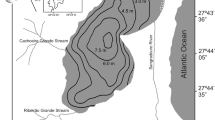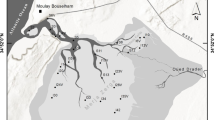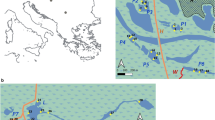Abstract
As compared to macroscopic invertebrates zoopsammon communities, i.e. fauna inhabiting interstitial spaces between sand grains are largely understudied and the factors affecting their spatiotemporal variability are not well known. In a field observation, we tested how seasonal variability in the taxonomic composition and density of zoopsammon communities at different shore heights is related to sand temperature, wave activity, sediment characteristics and vegetation cover in the two boreal lakes differing in their trophic state. The mesotrophic Lake Saadjärv had higher number of psammon taxa dominated by protists than the eutrophic Lake Võrtsjärv dominated by nematodes. Within each lake, vegetation cover and sediment characteristics explained the largest variability in the spatial and seasonal dynamics of zoopsammon communities. Seasonality differed among taxonomic groups and lakes. The seasonal variability differed slightly among the levels of shore heights with densities being highest at the water line in spring and early summer and upward the water line later on. Due to the presence of strong interaction of temporal and spatial variability in psammon communities, large covariation among environmental variables and a presence of many species-specific interactions with environmental factors, the future studies should test those impact attributes with experimental approaches at the highest taxonomic resolution possible.



Similar content being viewed by others
References
Alekperov, I. Kh. & E. S. Asadullayeva, 1999. New, little-known and characteristic ciliate species from the Apsheron coast of the Caspian Sea. Institute of Zoology, Azerbaijan Academy of Sciences, Baku-Azerbaijan. Turkish Journal of Zoology 23: 215–225.
Bielańska-Grajner, I., 2001. The psammic rotifer structure in three Lobelian Polish lakes differing in pH. Hydorobiologia 446/447: 149–153.
Bielańska-Grajner, I., 2004. Preliminary investigations of psammon rotifers in two reservoirs in Upper Silesia. Oceanological and Hydrobiological Studies 23: 37–45.
Bielańska-Grajner, I., 2005. The influence of biotic and abiotic factors on psammic rotifers in artificial and natural lakes. Hydorobiologia 546: 431–440.
Bielańska-Grajner, I. & M. Poznańska, 2010. The biodiversity of psammon rotifers in Włocławek Reservoir. Oceanological and Hydrobiological Studies 39: 111–117.
Bisby, F., Y. Roskov, A. Culham, T. Orrell, D. Nicolson, L. Paglinawan, N. Bailly, W. Appeltans, P. Kirk, T. Bourgoin, G. Baillargeon & D. Ouvrard, (eds) 2012. Species 2000 & ITIS Catalogue of Life, 3rd February 2012. Digital resource at www.catalogueoflife.org/col/. Species 2000: Reading, UK.
Boeckner, M. J., J. Sharma & H. C. Proctor, 2009. Revisiting the meiofauna paradox: dispersal and colonization of nematodes and other meiofaunal organisms in low- and high-energy environments. Hydorobiologia 624: 91–106.
Boero, F., 2001. Light after dark: the partnership for enhancing expertise in taxonomy. Trends in Ecology & Evolution 16: 266.
Brusca R. C. & G. J. Brusca, 2003. Invertebrates. Sinauer Associates Inc., Sunderland, USA.
Ejsmont-Karabin, J., 2001. Psammon rotifers in two lakes of different trophy—their abundance, species structure and role in phosphorous cycling. Verhandlungen des Internationalen Verein Limnologie 27: 3856–3859.
Ejsmont-Karabin, J., 2003. Rotifera of lake psammon: community structure versus trophic state of lake waters. Polish Journal of Ecology 51: 5–35.
Ejsmont-Karabin, J., 2004. Are community composition and abundance of psammon rotifera related to grain-size structure of beach sand in lakes? Polish Journal of Ecology 52: 363–368.
Ejsmont-Karabin, J., 2005. Short time-response of psammic communities of Rotifera to abiotic changes in their habitat. Hydorobiologia 546: 423–430.
Ejsmont-Karabin, J., 2008. Daily changes of the vertical microdistribution of rotifera in lake psammolittoral. Polish Journal of Ecology 56: 717–722.
Epstein, S. S., 1997. Microbial food webs in marine sediments. I. Trophic interactions and grazing rates in two tidal flat communities. Microbial Ecology 34: 188–198.
Evans, W. A., 1984. Seasonal abundances of the psammonic rotifers of a physically controlled stream. Hydorobiologia 108: 105–114.
Fenchel, T. & B. J. Finlay, 2004. The ubiquity of small species: patterns of local and global diversity. BioScience 54: 777–784.
Giere, O., 2009. Meiobenthology. The Microscopic Motile Fauna of Aquatic Sediments. Springer, Berlin.
Heip, C., M. Vincx & G. Vranken, 1985. The ecology of marine nematodes. Oceanography and Marine Biology: An Annual Review 23: 399–489.
Kalinowska, K., 2008. Psammon ciliates: diversity and abundance in hygroarenal of eutrophic lake. Polish Journal of Ecology 56: 259–271.
Kalinowska, K., J. Ejsmont-Karabin & J. I. Rybak, 2010. The role of lake shore sand deposits as bank of ciliate, rotifer and crustacean resting forms: experimental approach. Polish Journal of Ecology 58: 323–332.
Kotta, J. & G. Boucher, 2001. Interregional variation of free-living nematode assemblages in tropical coral sands. Cahiers de Biologie Marine 42: 315–326.
Lotufo, G. R., 1994. Cyclopina (Copepoda, Cyc1opoida) from Brazilian sandy beaches. Zoologica Scripta 23: 147–159.
Mäemets, A., 1977. Eesti NSV järved ja nende kaitse. Valgus, Tallinn.
Mazei, Y. A. & I. V. Burkovsky, 2003. Vertical structure of the interstitial ciliate community in the Chernaya River estuary (the White Sea). Protistology 3: 107–120.
Mazei, Y. A. & A. N. Tsyganov, 2006. Freshwater Testate Amoebae. KMK, Moscow. (in Russian).
Melone, G., C. Ricci, H. Segers & R. L. Wallace, 1998. Phylogenetic relationships of phylum Rotifera with emphasis on the families of Bdelloidea. Hydorobiologia 387(388): 101–107.
Michiels, I. C. & W. Traunspurger, 2005. Benthic community patterns and the composition of feeding-types and reproductive modes in nematodes. Nematology 7: 21–36.
Nelson, D. R. & N. J. Marley, 2000. The biology and ecology of lotic Tardigrada. Freshwater Biology 44: 93–108.
Nesteruk, T., 2007. Diversity and abundance of gastrotricha in the psammon of mesotrophic lake. Polish Journal of Ecology 55: 833–839.
Nogrady, T., R. L. Wallace & T. W. Snell, 1993. Rotifera. Biology, Ecology and Systematics. Guides to the Identification of the Microinvertebrates of the Continental Waters of the World 4, Vol. 1. SPB Academic Publishing bv, The Hague.
Nucci, P. R., A. Turra & E. H. Morgado, 2001. Diversity and distribution of crustaceans from 13 sheltered sandy beaches along São Sebastião Channel, South-Eastern Brazil. Journal of the Marine Biological Association of the United Kingdom 81: 475–484.
Ott, I. (ed.), 2007. Saadjärve limnoloogilised uurimused II. Eesti Maaülikooli Põllumajandus- ja Keskkonnainstituudi Limnoloogiakeskus.
Pejler, B., 1995. Relation to habitat in rotifers. Hydorobiologia 313/314: 267–278.
Pennak, R. W., 1940. Ecology of the microscopic Metazoa inhabiting the sandy beaches of some Wisconsin lakes. Ecological Monographs 10: 537–615.
Radwan, S. & I. Bielańska-Grajner, 2001. Ecological structure of psammic rotifers in the ecotonal zone of Lake Piaseczno (eastern Poland). Hydorobiologia 446/447: 221–228.
Radwan, S., T. Ozimek, I. Bielańska-Grajner & J. Sender, 2001. Structure of the water/land ecotones in trophically different Polish lakes. Verhandlungen des Internationalen Verein Limnologie 27: 3848–3851.
Ricci, C. & M. Balsamo, 2000. The biology and ecology of lotic rotifers and gastrotrichs. Freshwater Biology 44: 15–28.
Schmid-Araya, J. M., 1998. Rotifers in interstitial sediments. Hydorobiologia 387/388: 231–240.
Segers, H., 2007. Annotated checklist of the rotifers (Phylum Rotifera), with notes on nomenclature, taxonomy and distribution. Zootaxa 1564: 1–104.
Thane-Fenchel, A., 1968. Distribution and ecology of non-planktonic brackish-water rotifers from Scandinavian waters. Ophelia 5: 273–297.
The R Foundation for Statistical Computing, 2012. R version 2.14.2. http://www.r-project.org/. Accessed 15 May 2012.
Timm, T. (ed.), 1973. Võrtsjärv. Valgus, Tallinn.
Tuvikene, L., A. Kisand, I. Tõnno, & P. Nõges, 2004. Chemistry of lake water and bottom sediments. In J. Haberman, E. Pihu, & A. Raukas (eds), Lake Võrtsjärv. Estonian Encyclopaedia Publishers, Tallinn: 89–102.
Veit-Köhler, G., 2005. Influence of biotic and abiotic sediment factors on abundance and biomass of harpacticoid copepods in a shallow Antarctic bay. Scientia Marina 69: 135–145.
Whitman, R. L. & W. J. Clark, 1984. Ecological studies of the sand-dwelling community of an east Texas stream. Freshwater Invertebrate Biology 3: 59–79.
Wiszniewski, J., 1937. Differenciation écologiques des rotifères dans le psammon d’eaux Douces. Annales Musei Zoologici Polonici 12: 221–238. (Ref. Schmid-Araya, 1998).
Worm, B., E. B. Barbier, N. Beaumont, J. E. Duffy, C. Folke, B. S. Halpern, J. B. C. Jackson, H. K. Lotze, F. Micheli, S. R. Palumbi, E. Sala, K. A. Selkoe, J. J. Stachowicz & R. Watson, 2006. Impacts of biodiversity loss on ocean ecosystem services. Science 314: 787–790.
Acknowledgments
Funding for this research was provided by target financed project SF0180013s08 of the Estonian Ministry of Education and Research and by the Estonian Science Foundation grants 7813 and 8254. The study has been partly supported by the project “The status of marine biodiversity and its potential futures in the Estonian coastal sea” 3.2.0802.11-0029 of Environmental protection and technology programme of European Regional Fund. We also thank Dr. Tarmo Timm at the Centre for Limnology, the Estonian University of Life Sciences for identifying the oligochaete taxa.
Author information
Authors and Affiliations
Corresponding author
Additional information
Handling editor: P. Nõges
Electronic supplementary material
Below is the link to the electronic supplementary material.
Rights and permissions
About this article
Cite this article
Lokko, K., Virro, T. & Kotta, J. Testing effects of shore height level, sediment characteristics and vegetation cover on the seasonality of zoopsammon communities in the two boreal lakes differing in their trophic state. Hydrobiologia 700, 1–8 (2013). https://doi.org/10.1007/s10750-012-1210-1
Received:
Revised:
Accepted:
Published:
Issue Date:
DOI: https://doi.org/10.1007/s10750-012-1210-1




